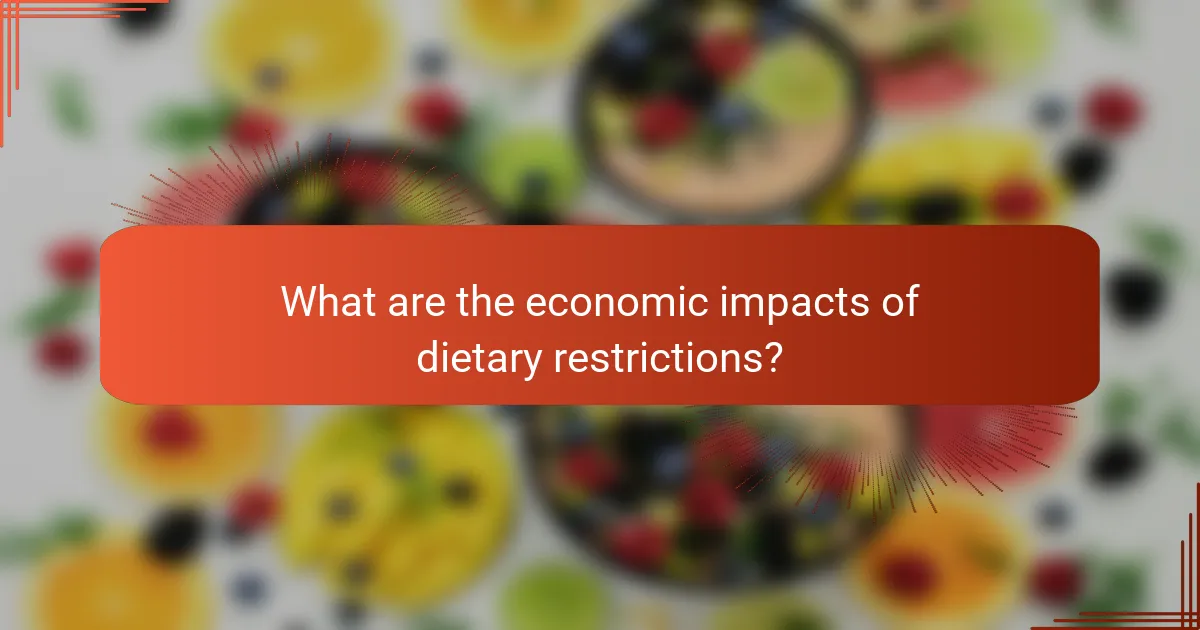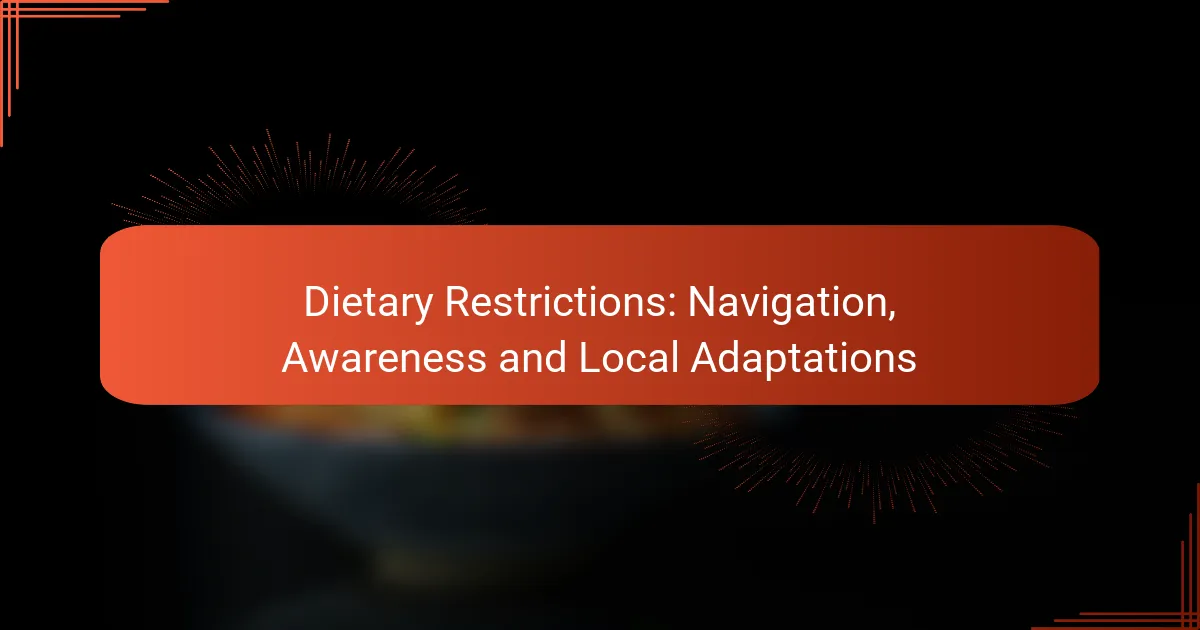Navigating dietary restrictions in urban dining environments, such as New York City, requires a keen understanding of menu options and effective communication with restaurant staff. With common restrictions like gluten intolerance, nut allergies, and veganism, it’s essential to be proactive in ensuring your dietary needs are met. Raising awareness about these restrictions fosters inclusivity and helps create supportive dining experiences for everyone.

How to navigate dietary restrictions in restaurants in New York City?
Navigating dietary restrictions in New York City restaurants involves understanding menu options, communicating with staff, and knowing which establishments cater to specific needs. Being proactive about your dietary requirements can enhance your dining experience and ensure your health is prioritized.
Menu customization options
Many restaurants in New York City offer menu customization options to accommodate dietary restrictions. Common practices include substituting ingredients, adjusting portion sizes, or creating entirely new dishes based on customer needs. When ordering, clearly specify your restrictions to help the kitchen provide a safe meal.
Some restaurants may have a “build your own” style menu, particularly in places like taco shops or salad bars, allowing for greater flexibility. Always inquire about hidden ingredients, such as sauces or dressings, that may contain allergens.
Staff training on dietary needs
Effective staff training on dietary needs is crucial for restaurants to ensure customer safety and satisfaction. Many establishments in NYC prioritize training their staff on common dietary restrictions, such as gluten-free, vegan, or nut-free diets. This training helps staff confidently answer questions and make informed recommendations.
When dining out, don’t hesitate to ask staff about their training regarding dietary needs. A knowledgeable server can significantly enhance your experience by providing accurate information and ensuring your meal meets your requirements.
Local dietary-friendly restaurants
New York City boasts a variety of restaurants that cater specifically to dietary restrictions. For gluten-free options, establishments like “Risotteria Melotti” and “By Chloe” are popular choices. Vegan and vegetarian diners can explore “Dirt Candy” or “Superiority Burger,” which offer innovative plant-based dishes.
To find restaurants that accommodate specific dietary needs, consider using apps or websites that filter options based on dietary preferences. Reading reviews can also provide insights into how well a restaurant handles dietary restrictions, ensuring a safe and enjoyable dining experience.

What are common dietary restrictions?
Common dietary restrictions include gluten intolerance, nut allergies, and veganism. These restrictions often stem from health concerns, ethical beliefs, or personal preferences and require careful navigation in food choices.
Gluten intolerance
Gluten intolerance, also known as non-celiac gluten sensitivity, affects individuals who experience adverse reactions to gluten, a protein found in wheat, barley, and rye. Symptoms may include digestive issues, fatigue, and joint pain. It’s essential for those affected to avoid foods containing gluten to prevent discomfort and health complications.
When shopping or dining out, look for gluten-free labels on products. Many restaurants now offer gluten-free options, but always confirm with staff to avoid cross-contamination. Common gluten-free grains include rice, quinoa, and corn.
Nut allergies
Nut allergies are among the most common food allergies, particularly in children, and can cause severe reactions. Individuals with nut allergies must avoid all forms of nuts, including peanuts, tree nuts, and products containing these ingredients. Cross-contamination is a significant concern, so vigilance is crucial.
When eating out, inform the restaurant staff about the allergy and ask about their procedures for preventing cross-contact. Always read ingredient labels carefully, as nuts can be hidden in many processed foods, including sauces and baked goods.
Veganism
Veganism is a lifestyle choice that excludes all animal products, including meat, dairy, and eggs. People choose veganism for various reasons, including health, environmental concerns, and animal welfare. A well-planned vegan diet can provide all necessary nutrients, but it requires attention to certain vitamins and minerals.
Vegans should ensure adequate intake of protein, iron, calcium, and vitamin B12, which can be sourced from legumes, nuts, seeds, fortified foods, and supplements. When dining out, look for restaurants that offer plant-based menus or vegan options to make meal choices easier.

How to raise awareness about dietary restrictions?
Raising awareness about dietary restrictions involves educating the public on various dietary needs and fostering understanding among communities. This can lead to more inclusive environments where individuals with specific dietary requirements feel supported and safe.
Educational campaigns
Educational campaigns are essential for informing the public about dietary restrictions, such as allergies, intolerances, and lifestyle choices like veganism or gluten-free diets. These campaigns can utilize brochures, posters, and informational sessions to reach diverse audiences.
Consider collaborating with local health organizations or schools to distribute materials that explain common dietary restrictions and their implications. Engaging storytelling can make the information more relatable and memorable.
Community workshops
Community workshops provide hands-on learning experiences about dietary restrictions. These can include cooking classes that focus on allergen-free recipes or discussions led by nutritionists on how to read food labels effectively.
Workshops should be tailored to the local community’s needs, addressing prevalent dietary issues in the area. Offering these sessions at community centers or local markets can increase participation and foster a sense of community support.
Social media initiatives
Social media initiatives can significantly amplify awareness of dietary restrictions by reaching a broader audience quickly. Creating engaging content, such as infographics, videos, and personal stories, can help demystify dietary needs and promote empathy.
Utilizing popular platforms like Instagram, Facebook, and TikTok allows for interactive discussions and sharing of experiences. Encourage followers to share their own stories and tips, creating a supportive online community around dietary awareness.

What are the best practices for food labeling?
Best practices for food labeling focus on providing clear, accurate, and comprehensive information to consumers. This ensures that individuals can make informed choices, especially those with dietary restrictions or allergies.
Clear allergen information
Clear allergen information is crucial for protecting consumers with food allergies. Labels should prominently display common allergens such as peanuts, tree nuts, dairy, eggs, soy, wheat, fish, and shellfish. Use bold text or a separate section to highlight these allergens, making them easily identifiable.
Consider using standardized phrases like “may contain” or “produced in a facility that processes” to inform consumers of potential cross-contamination risks. This transparency helps individuals manage their dietary needs effectively.
Ingredient transparency
Ingredient transparency involves listing all components of a food product in descending order by weight. This practice allows consumers to understand what they are consuming and to identify any ingredients they may wish to avoid. Use clear, common names rather than chemical terms to enhance understanding.
Additionally, consider highlighting any artificial additives or preservatives. Providing information about sourcing, such as organic or non-GMO, can also help consumers make choices aligned with their values.
Local regulations compliance
Compliance with local regulations is essential for food labeling. Different countries have specific requirements regarding what must be included on labels, such as nutritional information, serving sizes, and allergen declarations. Familiarize yourself with the regulations in your region, such as the FDA guidelines in the United States or the EU Food Information to Consumers Regulation.
Regularly review and update labels to ensure they meet current standards and reflect any changes in ingredients or formulations. Non-compliance can lead to penalties and loss of consumer trust, so staying informed is vital.

How to adapt recipes for dietary restrictions?
Adapting recipes for dietary restrictions involves substituting ingredients, using alternative cooking methods, and ensuring safety from cross-contamination. These strategies allow individuals with specific dietary needs to enjoy meals without compromising their health.
Substituting ingredients
Substituting ingredients is essential for accommodating dietary restrictions. For example, if a recipe calls for wheat flour, you can use almond flour or gluten-free flour blends for those with gluten intolerance. Similarly, dairy can often be replaced with almond milk or coconut yogurt for lactose-free diets.
When substituting, consider the texture and flavor of the alternatives. Some substitutes may require adjustments in cooking times or additional binding agents, like eggs or flaxseed meal, to achieve the desired consistency.
Using alternative cooking methods
Alternative cooking methods can help make recipes more suitable for various dietary needs. For instance, steaming vegetables instead of frying can reduce fat content, making dishes healthier. Grilling or baking can also enhance flavors without adding extra calories.
Consider using slow cookers or pressure cookers for meals that require longer cooking times. These methods can help tenderize ingredients and meld flavors while often requiring less added fat or sodium.
Testing for cross-contamination
Testing for cross-contamination is crucial for individuals with severe allergies or intolerances. Always use clean utensils and surfaces when preparing food to avoid unintentional exposure to allergens. For example, if you are cooking gluten-free meals, ensure that all cookware has not been used with gluten-containing foods.
Labeling and storing ingredients properly can also help prevent cross-contamination. Keep allergenic items separate and clearly marked, and consider using dedicated cooking tools for specific dietary needs to enhance safety.

What are the economic impacts of dietary restrictions?
Dietary restrictions can significantly influence economies by affecting food production, distribution, and consumption patterns. These impacts can lead to changes in market demand, pricing, and even agricultural practices as producers adapt to meet the needs of consumers with specific dietary requirements.
Impact on food production
Food production is directly affected by dietary restrictions as farmers and manufacturers adjust their offerings to cater to various dietary needs. For instance, the rise in demand for gluten-free products has led to an increase in the cultivation of gluten-free grains like quinoa and rice. This shift can also result in higher production costs as specialized farming practices may be required.
Additionally, producers may need to invest in new processing facilities or equipment to avoid cross-contamination, which can further increase operational expenses. These changes can lead to higher prices for consumers, particularly in regions where such products are not widely available.
Market demand and pricing
As dietary restrictions become more common, market demand for specific food items tends to rise. This increased demand can drive prices up, especially for niche products like vegan or allergen-free foods. Consumers may find that these specialized items often come at a premium compared to conventional options, which can strain budgets.
In contrast, some dietary restrictions can lead to lower demand for certain products, affecting their pricing and availability. For example, a decline in demand for red meat due to health concerns or ethical considerations can lead to lower prices for beef while increasing prices for plant-based alternatives.
Impact on local economies
Local economies can experience both positive and negative impacts from dietary restrictions. On one hand, the demand for local, organic, and specialty foods can boost local farmers and small businesses. Communities may benefit from increased job opportunities in food production and retail sectors catering to these dietary needs.
On the other hand, areas that rely heavily on traditional food sources may face economic challenges as dietary trends shift. For example, regions known for livestock farming may struggle if consumer preferences move towards plant-based diets, potentially leading to job losses and economic decline in those sectors.



